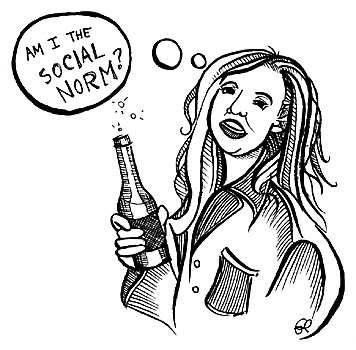
Illustration by Patricia Tompkins
|
|
By Lori Foley
Arizona Daily Wildcat
Thursday, October 20, 2005
Print this
Mark Twain usually gets credit for the quote "There are three kinds of lies: lies, damned lies and statistics," even though it was probably Benjamin Disraeli who first said it. But I've said it a bunch of times after both of them, and I'd like some credit too.
Not only was it a cleverly respectable way to say "damn" in class in high school, but it's also a fairly profound observation. Statistics are some of the wiliest things going, and the UA is hoping that we'll base our behaviors on some that they've posted for us.
The posters and print ads are emblazoned with images of our peers hanging out in multiethnic groups, intensely cheerful, with statistics on UA campus life, such as "80 percent of UA students did not damage property or get hurt/injured due to drinking" displayed in large and artistic fonts.
The posters cover the UA campus, and even the Arizona Daily Wildcat is rife with the ads. The basic premise behind Social Norms advertising is that students tend to have exaggerated perceptions of the extent to which their peers engage in various "risky behaviors."
Koreen Johannessen, the senior adviser for prevention with Campus Health Service, explained that her department "saw that students really thought that other students were more sexually active than they were. They thought there was more marijuana use, more tobacco use, more alcohol use" than there really is.
The Social Norms campaign was brought in to make it clear to students how uncommon it was for their peers to do these things, with the assumption students would do these things less themselves if they realized that they weren't the "norms" they may have assumed they were.
The Social Norms campaign at the UA costs about $17,000 each year and is funded with grants received by the Health Services Department. The money is spent on print ads in the Daily Wildcat, posters around campus and on overhead staff costs.
So is it worth it? The UA campaign reported an impressive 29 percent decrease in drinking during a three-year period of implementation of its complete Social Norms campaign, as well as a big reduction in alcohol violations at homecoming.
This is an unquestionably positive trend. The issue is whether or not the means by which this end is achieved are equally positive. Even though Social Norms campaigns really may help decrease negative student behavior on campuses, they might not be the best way to seek that change.
The specific goal of the campaign is that students will model their behaviors on what they think their peers are doing. But conflating good decisions and popular ones is a dangerous route to take. If a choice is a good one, it is regardless of whether or not peers are involved, and a horrible decision doesn't get any better because it's committed in a group.
One of the main points of the campaign is to present numbers without being judgmental. However, the goal is to change students' behavior. The desire to change an action implies that there is something negative about it in the first place, which is, in itself, a judgment.
Some things are just always wrong - such as not " respect(ing) the wishes of a date/partner if he/she says no to sexual activity," something 2 percent of UA undergraduates surveyed admitted to, which represents about 640 people on campus.
To pander to students and encourage them not to rape their dates because not too many others are doing it, though certainly well intentioned, is a dangerously lax approach to a very serious problem.
Rape is always wrong, as is drunken driving, another issue featured in the campaign. Some things are also always stupid, like drinking to the point that you're damaging property or yourself, something 20 percent of UA students report doing.
We need to handle the truth that some decisions are straight up bad, regardless of how many of us are engaged in them - and we need those running the campaigns to be big enough to say so.
Does this qualm with the mechanics of the campaign itself render it an overall negative one, despite its positive results? Oh, I don't know; what does the majority of my peer group think?
Lori Foley is a senior majoring in French and English. She can be reached at letters@wildcat.arizona.edu.
